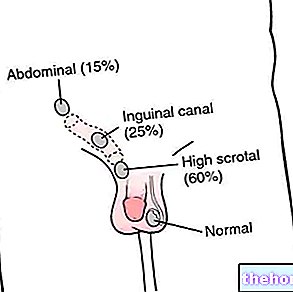Stage of the disease and complications
Uncomplicated ascites
For uncomplicated ascites, we mean an ascites that is not infected and is not associated with the onset of a hepato-renal syndrome.

Grade classification
- Grade 1 (mild). The ascites is detectable only with an ultrasound examination.
- Grade 2 (moderate). Ascites causes a moderate symmetrical distension of the abdomen, appreciable with the common semiological physical maneuvers.
- Grade 3 (marked). Ascites causes considerable abdominal distension.
Complicated ascites
- Refractory ascites;
- ascites with bacterial peritonitis (spontaneous or secondary);
- ascites with renal failure (hepatorenal syndrome).
Hepatic encephalopathy can also be among the complications of ascites (it manifests itself with symptoms such as mental confusion, changes in the level of consciousness, up to coma).
Refractory ascites
Refractory ascites are those that cannot be mobilized or that present an early reappearance, after paracentesis, and cannot be effectively prevented with simple medical therapy. There are two different subgroups:
• diuretic resistant ascites: these are ascites refractory to sodium restriction and to intense diuretic treatment (spironolactone 400 mg / day and furosemide 160 mg / day for at least one week) with a sodium restriction in the daily diet.
• Ascites intractable with diuretics: these are all those ascites refractory to a therapy with diuretics due to the onset of complications induced by these drugs.
Ascites with spontaneous bacterial peritonitis
Spontaneous bacterial peritonitis is the development of a "microbial infection of ascites" in the absence of an obvious contiguous focus of infection. Supported by intestinal germs, bacterial peritonitis is the most frequent and serious complication in patients with cirrhosis. In hospitalized individuals, the incidence varies between 10 and 30%. In the presence of peritonitis, mortality exceeds 90% but can be reduced to about 20% with early diagnosis and immediate antibiotic treatment.
Often asymptomatic, spontaneous bacterial peritonitis can manifest with symptoms such as fever, vomiting, confusion, and abdominal pain.
Hepato-renal syndrome
Hepato-renal syndrome is a rare, but potentially lethal, complication of ascites related to cirrhosis. It causes progressive renal failure, due to the sum of endogenous factors (reduced blood supply to the kidneys, water and electrolyte imbalances) and any exogenous factors (excessive use of diuretics or administration of drugs harmful to the kidney).
Symptoms of Ascites
For further information: Ascites - Causes and Symptoms
The symptoms of ascites depend on the causes of origin and the amount of intra-abdominal fluid. In mild forms, the patient is generally asymptomatic, while in marked ascites, he complains of abdominal pain, lack of appetite with early satiety, a sense of abdominal swelling and breathing difficulties with shortness of breath (due to the mechanical obstacle to the movement of the diaphragm and the accumulation of fluids around the lungs). To all these symptoms can be added those related to the diseases of origin, such as jaundice, muscle weakness and spider naevi (capillary dilations that converge in a central point, assuming the typical spider appearance), gynecomastia and palmar erythema.
Diagnosis
The diagnosis of ascites begins with the "physical examination of the patient combined with a" thorough medical history, necessary to formulate hypotheses on the possible causes of origin. In this regard, the doctor will ask the patient about: possible alcohol consumption, use of particular drugs, active liver disease, hepatitis and related risk factors, heart failure, family history of liver disease, etc.
If the accumulation of fluid in the abdominal cavity is greater than 500 ml, ascites can be diagnosed through simple physical maneuvers; vice versa, it becomes evident with a common abdominal ultrasound. Once identified, however, the clear identification of the causes of origin is essential; the first information will derive from in-depth blood tests, in which parameters such as complete blood count, albuminemia, prothrombin time, transaminase, bilirubin, natremia, kalaemia will be analyzed. At the same time, tests will also be carried out on the patient's urine, in order to investigate the degree of renal efficiency (creatinine clearance).
A very important test to be performed in the presence of ascites of unknown origin is exploratory paracentesis, which can also be used for therapeutic purposes (evacuative paracentesis). In practice, the ascitic fluid is collected using a fine needle under ultrasound guidance, inserted into the abdomen after skin disinfection. A series of analyzes are carried out on this sample, usually limited to a few decitiliters, such as the dosage of albumins and proteins, the neutrophil count, the culture of the fluid (to discover any infections), the search for amylase (index of pancreatic damage) and any cytological tests (in the case of a suspected neoplasm). The dosage of albumin in the ascitic fluid is important to establish the so-called serum-ascites albumin gradient - SAAG: if the ratio between serum albumin and ascitic albumin is higher than 1.1 the condition is linked to portal hypertension (cirrhosis or congestive heart failure); vice versa if the ratio is lower than 1.1 yes it is an exudate, therefore presumably inflammatory, neoplastic or tuberculous ascites.
In the presence of ascites, ultrasound is useful to evaluate the situation of the abdominal organs and the presence of splenomegaly (for the evaluation of portal hypertension).
More articles on "Ascites: Stage, Symptoms and Diagnosis"
- Acite
- Ascites: treatment
- Ascites - Medicines for the treatment of Ascites




























